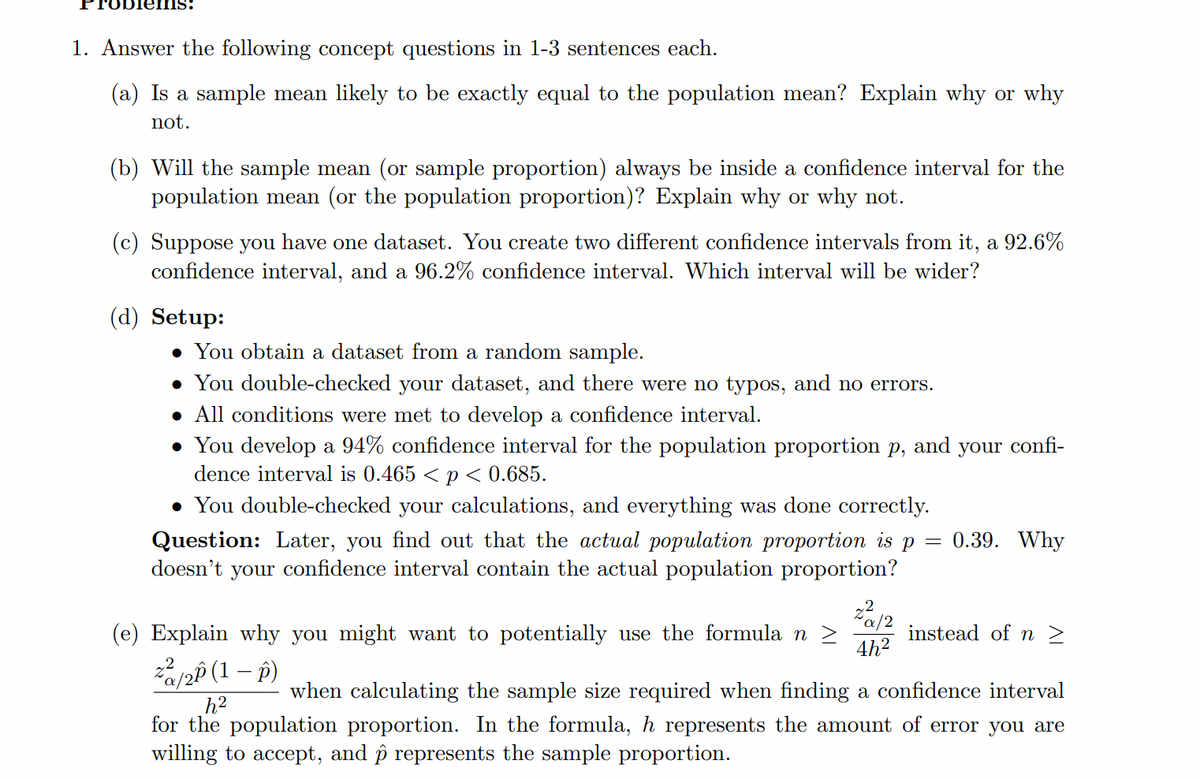(d) Setup: • You obtain a dataset from a random sample. • You double-checked your dataset, and there were no typos, and no errors. • All conditions were met to develop a confidence interval. • You develop a 94% confidence interval for the population proportion p, and your confi- dence interval is 0.465 < p < 0.685. • You double-checked your calculations, and everything was done correctly. Question: Later, you find out that the actual population proportion is p = 0.39. Why doesn't your confidence interval contain the actual population proportion? “a/2 instead of n > 4h2 (e) Explain why you might want to potentially use the formula n 2 2ô (1 – p) when calculating the sample size required when finding a confidence interval h2 for the population proportion. In the formula, h represents the amount of error you are willing to accept, and p represents the sample proportion.
(d) Setup: • You obtain a dataset from a random sample. • You double-checked your dataset, and there were no typos, and no errors. • All conditions were met to develop a confidence interval. • You develop a 94% confidence interval for the population proportion p, and your confi- dence interval is 0.465 < p < 0.685. • You double-checked your calculations, and everything was done correctly. Question: Later, you find out that the actual population proportion is p = 0.39. Why doesn't your confidence interval contain the actual population proportion? “a/2 instead of n > 4h2 (e) Explain why you might want to potentially use the formula n 2 2ô (1 – p) when calculating the sample size required when finding a confidence interval h2 for the population proportion. In the formula, h represents the amount of error you are willing to accept, and p represents the sample proportion.
Glencoe Algebra 1, Student Edition, 9780079039897, 0079039898, 2018
18th Edition
ISBN:9780079039897
Author:Carter
Publisher:Carter
Chapter4: Equations Of Linear Functions
Section: Chapter Questions
Problem 8SGR
Related questions
Question
Answer D and E

Transcribed Image Text:ems:
1. Answer the following concept questions in 1-3 sentences each.
(a) Is a sample mean likely to be exactly equal to the population mean? Explain why or why
not.
(b) Will the sample mean (or sample proportion) always be inside a confidence interval for the
population mean (or the population proportion)? Explain why or why not.
(c) Suppose you have one dataset. You create two different confidence intervals from it, a 92.6%
confidence interval, and a 96.2% confidence interval. Which interval will be wider?
(d) Setup:
You obtain a dataset from a random sample.
• You double-checked your dataset, and there were no typos, and no errors.
• All conditions were met to develop a confidence interval.
• You develop a 94% confidence interval for the population proportion p, and your confi-
dence interval is 0.465 < p< 0.685.
• You double-checked your calculations, and everything was done correctly.
0.39. Why
Question: Later, you find out that the actual population proportion is p
doesn't your confidence interval contain the actual population proportion?
(e) Explain why you might want to potentially use the formula n >
instead of n >
4h2
pô (1 – p)
h2
for the population proportion. In the formula, h represents the amount of error you are
willing to accept, and p represents the sample proportion.
when calculating the sample size required when finding a confidence interval
Expert Solution
This question has been solved!
Explore an expertly crafted, step-by-step solution for a thorough understanding of key concepts.
This is a popular solution!
Trending now
This is a popular solution!
Step by step
Solved in 2 steps

Recommended textbooks for you

Glencoe Algebra 1, Student Edition, 9780079039897…
Algebra
ISBN:
9780079039897
Author:
Carter
Publisher:
McGraw Hill

Glencoe Algebra 1, Student Edition, 9780079039897…
Algebra
ISBN:
9780079039897
Author:
Carter
Publisher:
McGraw Hill